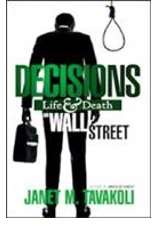 Janet Tavakoli, the president of Tavakoli Structured Finance and an authority on credit derivatives, has written a reflective memoir about life in the world of finance, and specifically about the ringside seat she occupied in the years leading up to the gravest financial crisis in history.
Janet Tavakoli, the president of Tavakoli Structured Finance and an authority on credit derivatives, has written a reflective memoir about life in the world of finance, and specifically about the ringside seat she occupied in the years leading up to the gravest financial crisis in history.
Early on in Tavakoli’s work on Merrill Lynch’s interest-rates swap desk, in the late 1980s, she understood that whenever that desk had a problem, “it had nothing to do with the swap. It was always a credit problem, and almost all of the serious credit problems for investor grade bonds involved fraud.” Tavakoli is not a woman who employs words carelessly, and when she says fraud she means … fraud.
One of her bosses on that desk was Bill Broeksmit, like her a Chicagoan come to New York. Bill joked in those days about the “Calvi collar” that Drexel Burnham executives ought to wear, given their criminality and the way it had led to Drexel’s demise. It was a bit of gallows humor that referred to banker Roberto Calvi, once known as “God’s Banker” because of his closeness with the Vatican. Calvi was discovered hanging from scaffolding beneath Blackfriars Bridge in London, in 1982, an apparent [actually a staged] suicide that has since been deemed a murder.
Broeksmit is first introduced to us in this book in a favorable light. He worked with Tavakoli on a swap that involved co-op loan securitization. Together they decided to disclose the risks clearly to Merrill’s customers, so those customers wouldn’t rely blindly on the credit rating agencies’ rubber stamp AAAs. The “Calvi collar” allusion seems a bit of character painting, a detail in Tavakoli’s story. In time their careers took them their separate ways. But….
More than an allusion
This allusion comes to seem more than detail late in the book, when Tavakoli tells us that Broeksmit hung himself by the neck in January 2014. He killed himself, that is, in precisely the way that he had once said would be appropriate for fraudsters.
Tavakoli writes that there “is no reason to believe that Bill’s death was anything other than suicide, but I was shocked by this method,” when she learned of it through Bloomberg News.
The previous summer, Broeksmit had been an object of an inquiry by the Bundesbank regarding what Tavakoli describes as “allegations that [Deutsche Bank] incorrectly valued its massive position in credit derivatives” when Broeksmit was a risk manager there.
Broeksmit must have understood the vulnerability of his position. If regulators had come to believe that there was a violation at Deutsche Bank, an involved but retired employee there would have been a tempting scapegoat for his still-active colleagues.
The Big Picture
Perhaps one measure of the seriousness of Deutsche Bank’s situation is the length to which it went to recapitalize itself. “In June 2014,” Tavakoli observes, “[it] raised $11.6 billion in capital after offering shareholders a 24% discount to buy more stock and selling new shares on the market.”
A dubious tax avoidance scheme in which both the bank and Broeksmit were involved may have enhanced his anxiety in his final months. Hedge funds, notably including Renaissance’s Medallion Fund, paid premiums to the bank for an equity basket option with expiration longer than a year so they could claim long term gains on trades that only took seconds.
Broeksmit’s life and death is only a small part of the picture Tavakoli draws together, but it may be THE vivid picture that many readers will take away (with the help of the noose in the cover art).
Her point throughout, though, is that the culture of global finance is dysfunctional at best, often blatantly criminal, and that its regulators serve as enablers.



